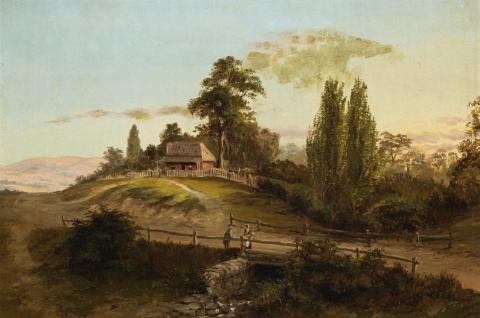EVENING, 1876
LOUIS BUVELOT
oil on canvas
29.5 x 43.5 cm
signed and dated lower right: L Buvelot 1876
inscribed verso: L. Buvelot / November 1876 / MAF
Norman G. Clark, Melbourne
Thence by descent
Norman K. Clark, Melbourne
Thence by descent
Private collection, Melbourne
The Swiss born Abram-Louis Buvelot arrived in Melbourne in 1865. Eugene von Guerard was then the young colony's leading artist. His landscapes were devoted to the sublime in nature, rendered in that thorough detail beloved by the German Romantics, of which he had complete command. By 1869, Buvelot had replaced him as the colony's leading landscape painter, his position sealed by the National Gallery of Victoria's purchase that year of his two 1866 paintings, Summer Afternoon, Templestowe and Winter Morning near Heidelberg. His international reputation was also growing through the award of gold and silver medals at major exhibitions. The young painters - Tom Roberts, Frederick McCubbin and Arthur Streeton - loved him, calling him the 'father' of Australian landscape painting. In 1880 Julian Ashton painted Buvelot's portrait, now in the collection of the Geelong Art Gallery, and six years later Roberts sketched him in pen and ink, to be followed by an etched portrait. On his death in 1888, a large retrospective exhibition was arranged by the National Gallery of Victoria. A few years later the National Gallery renamed one of its galleries in his honour.
Buvelot was so admired because, it was claimed, he led the way in seeing the beauty of the Australian landscape - no longer strange and primordial, rather homely and enveloped in luminous atmospheres. As a writer for the Melbourne Argus wrote in 1879,'... he has caused us to look upon our sylvan scenery with something like a new sense of vision.'1 This is apparent in Evening, 1876, a tranquil transcript of nature in which the civilizing hand is ever present. The heat and toil of noonday lie past as day slips peacefully into twilight.A man and a woman chat contently, close to home. Not the squatter's grand homestead of von Guerard's pastoral portraits. Rather, it is the worker's humble retreat, the fenced landscape of the bush now settled. Some of the surrounding trees are, like the settlers, of European origin, speaking of another home. The location is possibly Bacchus Marsh for Buvelot was sketching there in March 1876, as seen in drawings of the Lerderdergand Goodmans creeks in the collections of the National Gallery of Victoria, Art Gallery of Ballarat, and the Castlemaine Art Gallery and Historical Museum. There is also a very fine oil painting, Goodman's Creek, Bacchus Marsh, 1876 in the Art Gallery of New South Wales.2 In describing Buvelot as a landscape painter of 'the front rank', one of his contemporaries observed perceptively, 'He looks at Nature with the eye of a poet, and gives a poetical rendering of everything he depicts upon his canvas'.3
1. Argus, Melbourne, 11 September 1879, p. 4
2. The Art Gallery of New South Wales has three of Buvelot's 1876 oil paintings
3. Official Catalogue of Exhibits, Victorian Exhibition 1872, for the London International Exhibition of 1873, Melbourne 1872, p. 2
DAVID THOMAS
